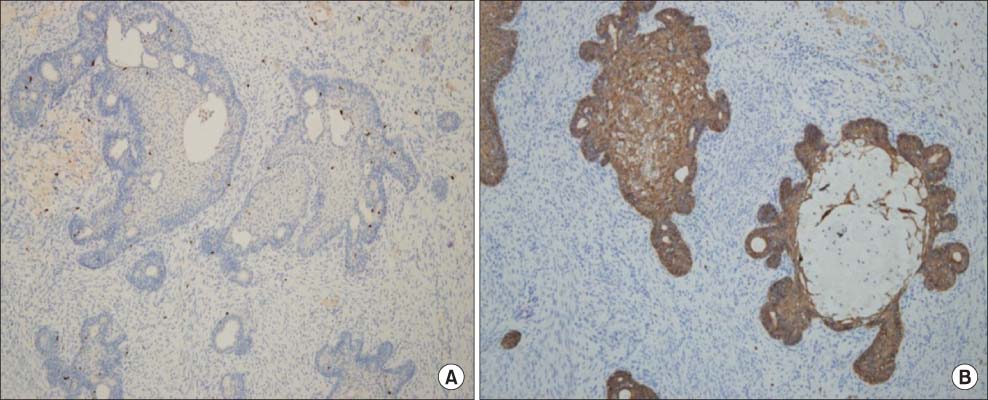J Menopausal Med.
2013 Dec;19(3):154-157. 10.6118/jmm.2013.19.3.154.
A Case of Adenoid Basal Carcinoma of the Uterine Cervix
- Affiliations
-
- 1Department of Obstetrics and Gynecology, Pusan National University School of Medicine, Yangsan, Korea. ohchoi@pusan.ac.kr
- KMID: 1939542
- DOI: http://doi.org/10.6118/jmm.2013.19.3.154
Abstract
- Adenoid basal carcinoma of the uterine cervix is uncommon neoplasia mostly occurring in postmenopausal women. It has excellent prognosis and a favorable clinical course. In addition, adenoid basal carcinoma is differentiated from adenoid cystic carcinoma by histologic and cellular morphologies, and immunohistochemistry. In this paper, we present the case of a 22 year old Korean female. She initially had a high-grade squamous intraepithelial lesion (HSIL) on Pap smear and a subsequent cervical loop electrosurgical excision procedure (LEEP) specimen revealing adenoid basal carcinoma. The lesion showed the histologic characteristics of adenoid basal carcinoma. Because of the lesion's low potential for recurrence and metastasis, the young primipara had a conization procedure performed and has been under close observation.
Keyword
MeSH Terms
Figure
Reference
-
1. Billroth T. Untersuchungen über die entwicklung der blutgefäße nebst beobachtungen aus der königlichen chirurgischen universitäts-klinik zu Berlin. Berlin: Reimer;1856.2. Tchertkoff V, Sedlis A. Cylindroma of the cervix. Am J Obstet Gynecol. 1962; 84:749–752.3. Baggish MS, Woodruff JD. Adenoid-basal carcinoma of the cervix. Obstet Gynecol. 1966; 28:213–218.4. Park J, Kim TH, Lee HH, Lee WS, Chung SH. Prevalence of human papilloma virus infection in perimenopausal women in Bucheon province. J Korean Soc Menopause. 2011; 17:155–159.5. Kim TH, Lee HH, Chung SH. Large, multilocular cystic mass in the uterine cervix mimicking adenoma malignum. J Korean Soc Menopause. 2011; 17:114–117.6. Ferry JA, Scully RE. "Adenoid cystic" carcinoma and adenoid basal carcinoma of the uterine cervix. A study of 28 cases. Am J Surg Pathol. 1988; 12:134–144.7. Brainard JA, Hart WR. Adenoid basal epitheliomas of the uterine cervix: a reevaluation of distinctive cervical basaloid lesions currently classified as adenoid basal carcinoma and adenoid basal hyperplasia. Am J Surg Pathol. 1998; 22:965–975.8. Lefrancq T, de Muret A, Michalak S, Lhuintre Y, Fetissof F. Adenoid basal carcinoma and adenoid cystic carcinoma of the uterine cervix. Ann Pathol. 1997; 17:196–199.9. Parwani AV, Smith Sehdev AE, Kurman RJ, Ronnett BM. Cervical adenoid basal tumors comprised of adenoid basal epithelioma associated with various types of invasive carcinoma: clinicopathologic features, human papillomavirus DNA detection, and P16 expression. Hum Pathol. 2005; 36:82–90.10. Kuroda N, Hirano K, Ohara M, Hirouchi T, Mizuno K, Kubo A, et al. Adenoid basal carcinoma arising in the cervical polyp: an immunohistochemical study of stromal cells. Med Mol Morphol. 2007; 40:112–114.11. Grayson W, Taylor LF, Cooper K. Adenoid cystic and adenoid basal carcinoma of the uterine cervix: comparative morphologic, mucin, and immunohistochemical profile of two rare neoplasms of putative 'reserve cell' origin. Am J Surg Pathol. 1999; 23:448–458.
- Full Text Links
- Actions
-
Cited
- CITED
-
- Close
- Share
- Similar articles
-
- A case of adenoid basal cell carcinoma in uterine cervix
- Adenoid Basal Carcinoma and Adenoid Cystic Carcinoma of the Uterine Cervix: A Study of 2 Cases
- A Case of Adenoid Basal Carcinoma of Uterine Cervix
- A Case of Adenoid Basal Carcinoma of the Uterine Cervix
- Adenoid Basal Carcinoma Associated with Invasive Squamous Cell Carcinoma of Uterine Cervix: A case report



